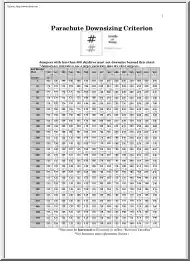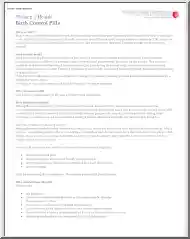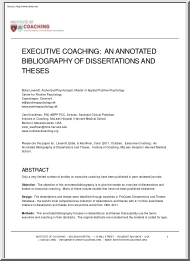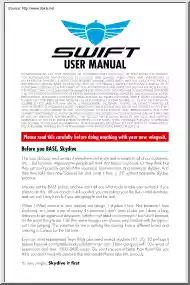No comments yet. You can be the first!
Content extract
Comment The study by Nicolas Bréchot and colleagues examined the use of a highly specialised intervention (ECMO) for a rare presentation (cardiogenic shock) of a common illness (sepsis). Few clinicians will need to apply the results of this study in clinical practice but, for those who do, it will probably save lives. I declare no competing interests. 4 5 6 7 Graeme MacLaren graeme maclaren@nuhs.edusg 8 Cardiothoracic Intensive Care Unit, National University Health System, Singapore 119074, Singapore 9 1 2 3 Singer M, Deutschman CS, Seymour CW, et al. The third international consensus definitions for sepsis and septic shock (Sepsis-3). JAMA 2016; 315: 801–10. Cecconi M, Evans L, Levy M, Rhodes A. Sepsis and septic shock Lancet 2018; 392: 75–87. Davis AL, Carcillo JA, Aneja RK, et al. American College of Critical Care Medicine clinical practice parameters for hemodynamic support of pediatric and neonatal septic shock. Crit Care Med 2017; 45: 1061–93 10 11 Weiss SL,
Peters MJ, Alhazzani W, et al. Surviving Sepsis Campaign International Guidelines for the management of septic shock and sepsisassociated organ dysfunction in children. Pediatr Crit Care Med 2020; 21: e52–106. Schlapbach LJ, MacLaren G, Festa M, et al. Prediction of pediatric sepsis mortality within 1h of intensive care admission. Intensive Care Med 2017; 43: 1085–96. Cvetkovic M, Lutman D, Ramnarayan P, Pathan N, Inwald DP, Peters MJ. Timing of death in children referred for intensive care with severe sepsis: implications for interventional studies. Pediatr Crit Care Med 2015; 16: 410–17 Bréchot N, Hajage D, Kimmoun A, et al. Venoarterial extracorporeal membrane oxygenation to rescue sepsis-induced cardiogenic shock: a retrospective, multicentre, international cohort study. Lancet 2020; 396: 545–52 Bartlett RH. Extracorporeal support for septic shock Pediatr Crit Care Med 2007; 8: 498–99. MacLaren G, Butt W, Best D, Donath S, Taylor A. Extracorporeal membrane oxygenation
for refractory septic shock in children: one institution’s experience. Pediatr Crit Care Med 2007; 8: 447–51 Schlapbach LJ, Chiletti R, Straney L, et al. Defining benefit threshold for extracorporeal membrane oxygenation in children with sepsisa binational multicenter cohort study. Crit Care 2019; 23: 429 Combes A, Hajage D, Capellier G, et al. Extracorporeal membrane oxygenation for severe acute respiratory distress syndrome. N Engl J Med 2018; 378: 1965–75. Child malnutrition and COVID-19: the time to act is now The COVID-19 pandemic is undermining nutrition across the world, particularly in low-income and middle-income countries (LMICs).1 The worst conse quences are borne by young children. Some of the strategies to respond to COVID-19including physical distancing, school closures, trade restrictions, and country lock downsare impacting food systems by disrupting the production, transportation, and sale of nutritious, fresh, and affordable foods, forcing millions of
families to rely on nutrient-poor alternatives. Strained health systems and interruptions in humanitarian response are eroding access to essential and often life-saving nutrition services.2 Social protection systems in many LMICs are overloaded as vulnerable families struggle to access the food and services they need in the context of an economic downturn. Malnutrition could exacerbate the effects of COVID-19 in mothers and children. At the same time, more children are becoming malnourished due to the deteriorating quality of their diets, interruptions in nutrition and other essential services, and the socioeconomic shocks created by the pandemic in LMICs. New estimates by Derek Headey and colleagues3 in an accompanying Comment in The Lancet suggest that without timely action, the global prevalence of child wasting could rise by a shocking 14·3%. With an www.thelancetcom Vol 396 August 22, 2020 estimated 47 million children younger than 5 years affected by wasting globally before the
COVID-19 pandemic,4 this would translate to an estimated additional 6·7 million children with wasting during the first 12 months of the pandemic80% of them in sub-Saharan Africa and south Asiaand more than 10 000 additional child deaths per month during this same period.3 With services for the prevention and treatment of wasting to a large extent up-ended in LMICs, millions of children are at risk of not receiving the care they need to survive and thrive. UNICEF reports from the early months of the COVID-19 pandemic suggest a 30% reduction in the coverage of essential nutrition services in LMICs and declines of 75–100% under lockdown contexts.5 Our agencies estimate that a minimum of US$2·4 billion is needed immediately to protect these children, prevent and treat malnutrition, and avoid human loss. This $2·4 billion estimate includes an essential package of four life-saving interventions: prevention of wasting in children at risk; treatment for children who are wasted; biannual
vitamin A supplementation for children aged 6–59 months (90% coverage); and mass communication for the protection, promotion, and support of breastfeeding that focuses on caregivers or families of children aged 0–23 months. Published Online July 27, 2020 https://doi.org/101016/ S0140-6736(20)31648-2 See Comment page 519 517 Comment Panel: Five urgent actions to protect children’s right to nutrition in the COVID-19 pandemic • Safeguard and promote access to nutritious, safe, and affordable diets • Invest in improving maternal and child nutrition through pregnancy, infancy, and early childhood • Re-activate and scale up services for the early detection and treatment of child wasting • Maintain the provision of nutritious and safe school meals for vulnerable children • Expand social protection to safeguard access to nutritious diets and essential services The estimated increase in child wasting is only the tip of the iceberg. The COVID-19 pandemic is also
expected to increase other forms of child malnutrition, including stunting, micronutrient defi ciencies, and overweight. The global community’s failure to act now will have devastating long-term consequences for children, human capital, and national economies. As leaders of four UN agencies, we are issuing a call for action to protect children’s right to nutrition in the face of the COVID-19 pandemic. This requires a swift response and investments from governments, donors, the private sector, and the UN. Five actions must be taken and tracked immediately (panel). First, access to nutritious, safe, and affordable diets needs to be safeguarded and promoted as a cornerstone of the response to COVID-19. This can be done by protecting food producers, processors, and retailers; discouraging trade bans; and designating food markets to be essential services and keeping them functioning and safe for workers and consumers. Second, investments are needed to improve maternal and child
nutrition through pregnancy, infancy, and early childhood by protecting breastfeeding and pre venting the inappropriate marketing of infant formula in the context of COVID-19;6 securing children and women’s access to nutritious and diverse foods; and providing accurate information on infant feeding to caregivers. Third, services for the early detection and treatment of child wasting need to be re-activated and scaled up while maintaining and expanding prevention and other nutrition services, including vitamin A supplementation for children, and micronutrient supplementation and nutritional support for pregnant 518 and breastfeeding women, and minimising the risk of infection. Fourth, maintain the provision of nutritious and safe school meals for vulnerable children through home delivery, take-home rations, and cash or vouchers when schools are closed. These efforts also need to ensure adequate nutritional value of school meals or food packages and avoid the provision of unhealthy
foods and beverages. Finally, social protection to safeguard access to nutri tious diets and essential services among the poorest households, including access to fortified foods, needs to be expanded. Such schemes must reach families with young children and pregnant and breastfeeding women. Our teams in countries everywhere stand ready to support governments and partners in implementing these five actions now. We must step forward together with sustained action and investments on nutrition today and deny the COVID-19 crisis an intergenerational legacy of hunger and malnutrition in children. HHF is Executive Director of UNICEF. QD is Director-General of the Food and Agriculture Organization of the United Nations. DMB is Executive Director of the Word Food Programme. TAG is Director-General of WHO We declare no competing interests. 2020. United Nations Published by Elsevier Ltd/Inc/BV All rights reserved. *Henrietta H Fore, Qu Dongyu, David M Beasley, Tedros A Ghebreyesus
hfore@unicef.org United Nations Children’s Fund, New York, NY 10017, USA (HHF); Food and Agriculture Organization of the United Nations, Rome, Italy (QD); World Food Programme, Rome, Italy (DMB); and World Health Organization, Geneva, Switzerland (TAG) 1 2 3 4 5 6 United Nations. The impact of COVID-19 on food security and nutrition. 2020 http://wwwfaoorg/policy-support/tools-andpublications/resources-details/es/c/1287907/ (accessed July 21, 2020). Roberton T, Carter ED, Chou VB, et al. Early estimates of the indirect effects of the COVID-19 pandemic on maternal and child mortality in low-income and middle-income countries: a modelling study. Lancet Glob Health 2020; 8: e901–08. Headey D, Heidkamp R, Osendarp S, et al. Impacts of COVID-19 on childhood malnutrition and nutrition-related mortality. Lancet 2020; published online July 27. https://doiorg/101016/ S0140-6736(20)31647-0. UNICEF, WHO, World Bank Group. Joint malnutrition estimates, 2020 edition. 2020
https://wwwwhoint/publications/i/item/ jme-2020-edition (accessed July 21, 2020). UNICEF. Situation tracking for COVID-19 socio-economic impacts June, 2020. https://datauniceforg/resources/rapid-situationtracking-covid-19-socioeconomic-impacts-data-viz/ (accessed July 21, 2020). WHO. Breastfeeding and COVID-19 Scientific brief June 23, 2020 https://www.whoint/news-room/commentaries/detail/breastfeedingand-covid-19 (accessed July 21, 2020) www.thelancetcom Vol 396 August 22, 2020
Peters MJ, Alhazzani W, et al. Surviving Sepsis Campaign International Guidelines for the management of septic shock and sepsisassociated organ dysfunction in children. Pediatr Crit Care Med 2020; 21: e52–106. Schlapbach LJ, MacLaren G, Festa M, et al. Prediction of pediatric sepsis mortality within 1h of intensive care admission. Intensive Care Med 2017; 43: 1085–96. Cvetkovic M, Lutman D, Ramnarayan P, Pathan N, Inwald DP, Peters MJ. Timing of death in children referred for intensive care with severe sepsis: implications for interventional studies. Pediatr Crit Care Med 2015; 16: 410–17 Bréchot N, Hajage D, Kimmoun A, et al. Venoarterial extracorporeal membrane oxygenation to rescue sepsis-induced cardiogenic shock: a retrospective, multicentre, international cohort study. Lancet 2020; 396: 545–52 Bartlett RH. Extracorporeal support for septic shock Pediatr Crit Care Med 2007; 8: 498–99. MacLaren G, Butt W, Best D, Donath S, Taylor A. Extracorporeal membrane oxygenation
for refractory septic shock in children: one institution’s experience. Pediatr Crit Care Med 2007; 8: 447–51 Schlapbach LJ, Chiletti R, Straney L, et al. Defining benefit threshold for extracorporeal membrane oxygenation in children with sepsisa binational multicenter cohort study. Crit Care 2019; 23: 429 Combes A, Hajage D, Capellier G, et al. Extracorporeal membrane oxygenation for severe acute respiratory distress syndrome. N Engl J Med 2018; 378: 1965–75. Child malnutrition and COVID-19: the time to act is now The COVID-19 pandemic is undermining nutrition across the world, particularly in low-income and middle-income countries (LMICs).1 The worst conse quences are borne by young children. Some of the strategies to respond to COVID-19including physical distancing, school closures, trade restrictions, and country lock downsare impacting food systems by disrupting the production, transportation, and sale of nutritious, fresh, and affordable foods, forcing millions of
families to rely on nutrient-poor alternatives. Strained health systems and interruptions in humanitarian response are eroding access to essential and often life-saving nutrition services.2 Social protection systems in many LMICs are overloaded as vulnerable families struggle to access the food and services they need in the context of an economic downturn. Malnutrition could exacerbate the effects of COVID-19 in mothers and children. At the same time, more children are becoming malnourished due to the deteriorating quality of their diets, interruptions in nutrition and other essential services, and the socioeconomic shocks created by the pandemic in LMICs. New estimates by Derek Headey and colleagues3 in an accompanying Comment in The Lancet suggest that without timely action, the global prevalence of child wasting could rise by a shocking 14·3%. With an www.thelancetcom Vol 396 August 22, 2020 estimated 47 million children younger than 5 years affected by wasting globally before the
COVID-19 pandemic,4 this would translate to an estimated additional 6·7 million children with wasting during the first 12 months of the pandemic80% of them in sub-Saharan Africa and south Asiaand more than 10 000 additional child deaths per month during this same period.3 With services for the prevention and treatment of wasting to a large extent up-ended in LMICs, millions of children are at risk of not receiving the care they need to survive and thrive. UNICEF reports from the early months of the COVID-19 pandemic suggest a 30% reduction in the coverage of essential nutrition services in LMICs and declines of 75–100% under lockdown contexts.5 Our agencies estimate that a minimum of US$2·4 billion is needed immediately to protect these children, prevent and treat malnutrition, and avoid human loss. This $2·4 billion estimate includes an essential package of four life-saving interventions: prevention of wasting in children at risk; treatment for children who are wasted; biannual
vitamin A supplementation for children aged 6–59 months (90% coverage); and mass communication for the protection, promotion, and support of breastfeeding that focuses on caregivers or families of children aged 0–23 months. Published Online July 27, 2020 https://doi.org/101016/ S0140-6736(20)31648-2 See Comment page 519 517 Comment Panel: Five urgent actions to protect children’s right to nutrition in the COVID-19 pandemic • Safeguard and promote access to nutritious, safe, and affordable diets • Invest in improving maternal and child nutrition through pregnancy, infancy, and early childhood • Re-activate and scale up services for the early detection and treatment of child wasting • Maintain the provision of nutritious and safe school meals for vulnerable children • Expand social protection to safeguard access to nutritious diets and essential services The estimated increase in child wasting is only the tip of the iceberg. The COVID-19 pandemic is also
expected to increase other forms of child malnutrition, including stunting, micronutrient defi ciencies, and overweight. The global community’s failure to act now will have devastating long-term consequences for children, human capital, and national economies. As leaders of four UN agencies, we are issuing a call for action to protect children’s right to nutrition in the face of the COVID-19 pandemic. This requires a swift response and investments from governments, donors, the private sector, and the UN. Five actions must be taken and tracked immediately (panel). First, access to nutritious, safe, and affordable diets needs to be safeguarded and promoted as a cornerstone of the response to COVID-19. This can be done by protecting food producers, processors, and retailers; discouraging trade bans; and designating food markets to be essential services and keeping them functioning and safe for workers and consumers. Second, investments are needed to improve maternal and child
nutrition through pregnancy, infancy, and early childhood by protecting breastfeeding and pre venting the inappropriate marketing of infant formula in the context of COVID-19;6 securing children and women’s access to nutritious and diverse foods; and providing accurate information on infant feeding to caregivers. Third, services for the early detection and treatment of child wasting need to be re-activated and scaled up while maintaining and expanding prevention and other nutrition services, including vitamin A supplementation for children, and micronutrient supplementation and nutritional support for pregnant 518 and breastfeeding women, and minimising the risk of infection. Fourth, maintain the provision of nutritious and safe school meals for vulnerable children through home delivery, take-home rations, and cash or vouchers when schools are closed. These efforts also need to ensure adequate nutritional value of school meals or food packages and avoid the provision of unhealthy
foods and beverages. Finally, social protection to safeguard access to nutri tious diets and essential services among the poorest households, including access to fortified foods, needs to be expanded. Such schemes must reach families with young children and pregnant and breastfeeding women. Our teams in countries everywhere stand ready to support governments and partners in implementing these five actions now. We must step forward together with sustained action and investments on nutrition today and deny the COVID-19 crisis an intergenerational legacy of hunger and malnutrition in children. HHF is Executive Director of UNICEF. QD is Director-General of the Food and Agriculture Organization of the United Nations. DMB is Executive Director of the Word Food Programme. TAG is Director-General of WHO We declare no competing interests. 2020. United Nations Published by Elsevier Ltd/Inc/BV All rights reserved. *Henrietta H Fore, Qu Dongyu, David M Beasley, Tedros A Ghebreyesus
hfore@unicef.org United Nations Children’s Fund, New York, NY 10017, USA (HHF); Food and Agriculture Organization of the United Nations, Rome, Italy (QD); World Food Programme, Rome, Italy (DMB); and World Health Organization, Geneva, Switzerland (TAG) 1 2 3 4 5 6 United Nations. The impact of COVID-19 on food security and nutrition. 2020 http://wwwfaoorg/policy-support/tools-andpublications/resources-details/es/c/1287907/ (accessed July 21, 2020). Roberton T, Carter ED, Chou VB, et al. Early estimates of the indirect effects of the COVID-19 pandemic on maternal and child mortality in low-income and middle-income countries: a modelling study. Lancet Glob Health 2020; 8: e901–08. Headey D, Heidkamp R, Osendarp S, et al. Impacts of COVID-19 on childhood malnutrition and nutrition-related mortality. Lancet 2020; published online July 27. https://doiorg/101016/ S0140-6736(20)31647-0. UNICEF, WHO, World Bank Group. Joint malnutrition estimates, 2020 edition. 2020
https://wwwwhoint/publications/i/item/ jme-2020-edition (accessed July 21, 2020). UNICEF. Situation tracking for COVID-19 socio-economic impacts June, 2020. https://datauniceforg/resources/rapid-situationtracking-covid-19-socioeconomic-impacts-data-viz/ (accessed July 21, 2020). WHO. Breastfeeding and COVID-19 Scientific brief June 23, 2020 https://www.whoint/news-room/commentaries/detail/breastfeedingand-covid-19 (accessed July 21, 2020) www.thelancetcom Vol 396 August 22, 2020




 When reading, most of us just let a story wash over us, getting lost in the world of the book rather than paying attention to the individual elements of the plot or writing. However, in English class, our teachers ask us to look at the mechanics of the writing.
When reading, most of us just let a story wash over us, getting lost in the world of the book rather than paying attention to the individual elements of the plot or writing. However, in English class, our teachers ask us to look at the mechanics of the writing.